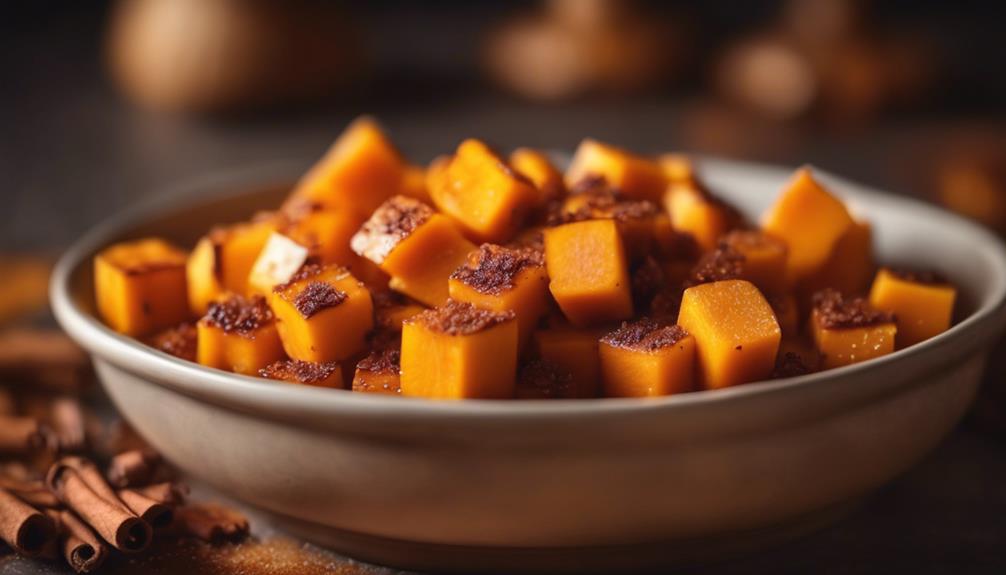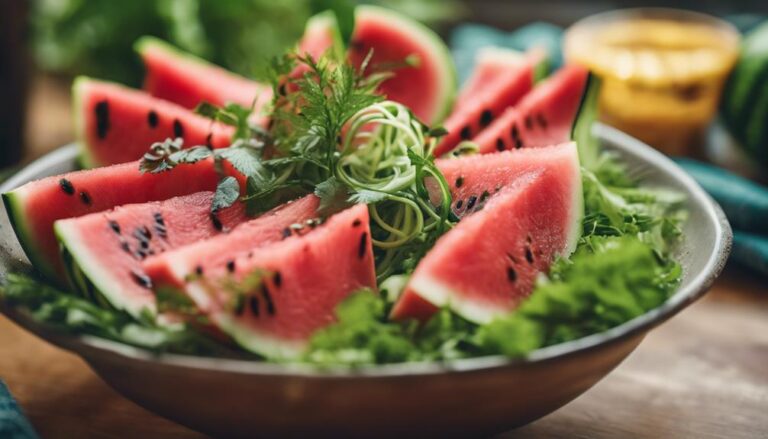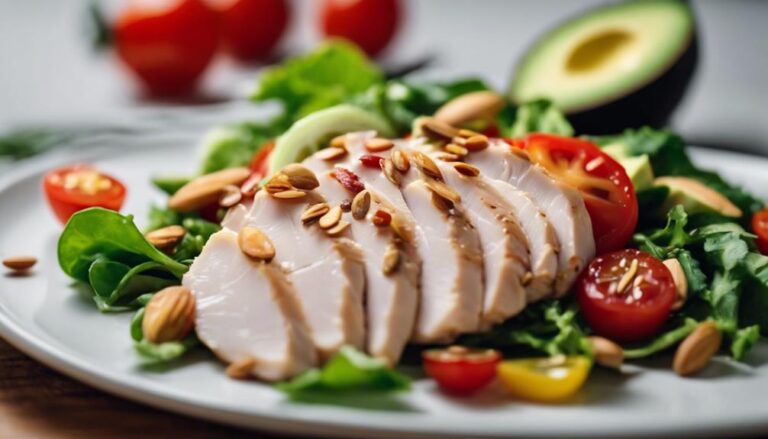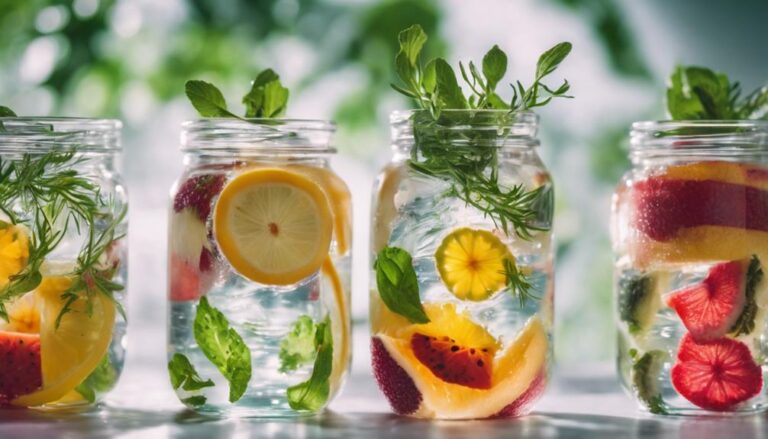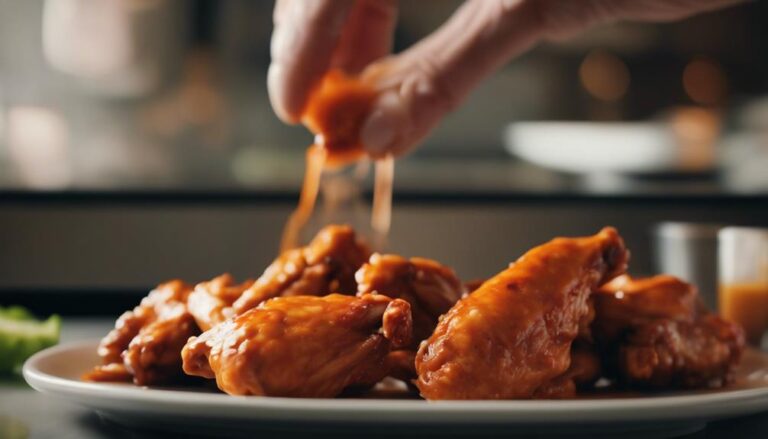Sous Vide Butternut Squash With Cinnamon and Nutmeg
Improve butternut squash with cinnamon and nutmeg using precise sous vide techniques. Seal the squash with spices in a bag, cook at 185°F (85°C) for rich flavors. Sous vide guarantees even infusion without losing nutrients. Maintain temperature precisely for tender, flavorful results. Want to master sous vide butternut squash?…
What You Will Learn Here
- Sous vide butternut squash with cinnamon and nutmeg enhances natural sweetness.
- Cooking at 185°F (85°C) ensures flavors permeate without overcooking.
- Precise temperature control guarantees even cooking and texture.
- Retain nutrients and flavors while infusing warm spices for a delightful dish.
- Personalize the recipe with additional ingredients for varied flavor profiles.
Origin of Sous Vide
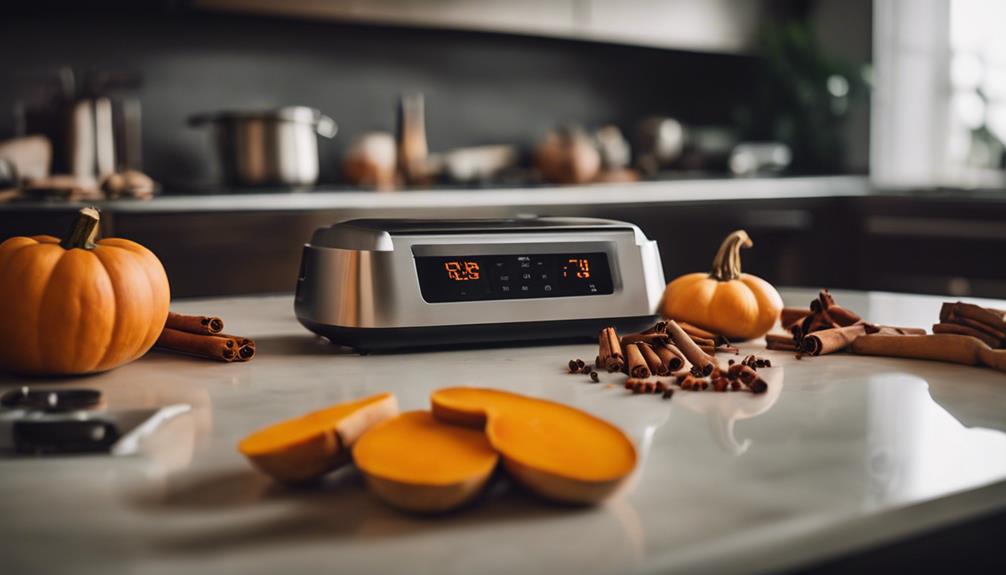
Sous vide cooking originated in France in the 1970s and was pioneered by Chef Georges Pralus to preserve the quality of foie gras. The term 'sous vide' signifies 'under vacuum' in French, highlighting the practice of vacuum-sealing food in airtight bags.
This method's precision in temperature control has led to its widespread adoption for consistent and flavorful results in various culinary applications.
Sous Vide History
Pioneered by French chef Georges Pralus in the 1970s, the culinary technique known as sous vide revolutionized cooking methods with its precise control over temperature and extended cooking times.
The term 'sous vide,' meaning 'under vacuum' in French, underscores the method's use of vacuum-sealing for cooking. Initially utilized by Pralus to preserve the color and texture of foie gras, sous vide involves cooking food in a precisely regulated water bath at a consistent low temperature for an extended duration, ensuring uniform cooking throughout.
Chefs like Thomas Keller and Heston Blumenthal later popularized sous vide for its accuracy in flavor retention and dependable outcomes. This technique has since become prevalent in both professional and home kitchens, offering meticulous control over the texture and doneness of dishes.
Sous Vide Technique
Originating in France in the 1970s, the sous vide technique revolutionized cooking methods by introducing a precise and controlled approach to cooking food in vacuum-sealed bags at consistent low temperatures in a water bath.
Sous vide cooking guarantees precise temperature control, eliminating the risk of overcooking and resulting in perfectly cooked dishes. Immersion circulators, such as the Anova Precision Sous Vide Cooker, are commonly used in sous vide cooking to heat and circulate water at the desired temperature.
The water displacement method, which involves removing air from vacuum-sealed bags by submerging them in water, ensures efficient and uniform cooking. This technique is popular for producing tender, flavorful, and evenly cooked meals, making it a preferred choice for both home cooks and professional chefs.
Sous Vide Benefits
With its roots in the culinary landscape of 1970s France, the sous vide technique has revolutionized cooking practices with its precise and controlled approach to food preparation. Sous vide makes it possible to cook food evenly at controlled temperatures, leading to enhanced flavors, textures, and juiciness.
The method of cooking in vacuum-sealed bags in a water bath, as the term 'sous vide' translates to 'under vacuum' in French, guarantees that ingredients retain their natural juices and flavors. This cooking approach has become increasingly popular due to its ability to deliver consistent results, making it a favorite among professional chefs and home cooks alike.
Sous vide's versatility extends to a wide range of foods, from meats and vegetables to desserts, allowing for exceptional outcomes every time.
Butternut Squash Varieties
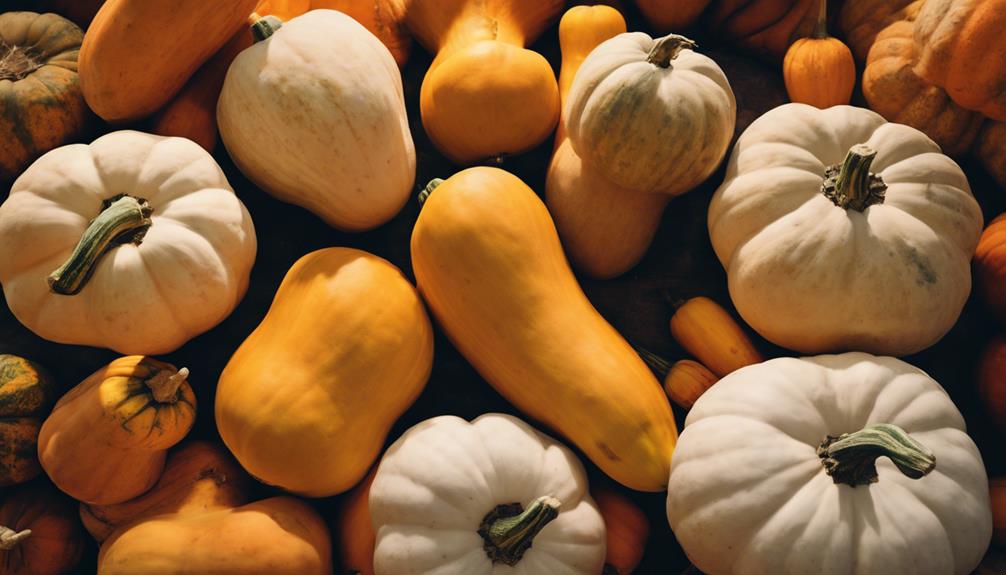
Selecting the best butternut squash variety for your dish can greatly impact the flavor and texture of your final creation. Butternut squash varieties such as Waltham, Butterscotch, and Butterbush offer distinct flavors and textures that cater to different culinary preferences:
- Waltham Butternut Squash: Known for its sweet, nutty flavor and creamy texture, ideal for various recipes.
- Butterscotch Butternut Squash: Offers a rich, sweet flavor reminiscent of caramel, perfect for both desserts and savory dishes.
- Butterbush Butternut Squash: A compact variety suitable for smaller spaces, producing smaller fruits with a taste profile similar to traditional butternut squash.
- Unique Flavors: Each variety brings a unique taste to your dishes, enhancing the overall culinary experience.
- Consider Preferences: Understanding the differences in butternut squash varieties can help you choose the best option based on your recipe requirements or personal taste preferences.
Sous Vide Butternut Squash Variations
Explore a range of delicious possibilities with Sous Vide Butternut Squash Variations.
Try creating Sous Vide Butternut Squash Medallions for an elegant presentation.
Whip up a comforting Butternut Squash Soup Recipe.
Indulge in crispy Butternut Squash Fries for a tasty snack.
These options showcase the versatility of butternut squash in sous vide cooking, offering unique textures and flavors to suit your preferences.
Sous Vide Butternut Squash Medallions
For optimal texture and flavor, sous vide butternut squash medallions are cooked precisely at 185°F (85°C), seasoned with warm spices like cinnamon and nutmeg to enhance the inherent sweetness of the squash. This cooking method guarantees consistent cooking throughout the squash, resulting in tender and flavorful medallions. Butternut squash medallions can be easily personalized with additional ingredients like honey or maple syrup for a unique flavor profile.
The sous vide process helps preserve the nutrients and flavors of the butternut squash, making it a nutritious and tasty side dish option.
- Tender and flavorful medallions
- Customizable with honey or maple syrup
- Consistent cooking throughout
- Preserves nutrients and flavors
- Nutritious and tasty side dish option
Butternut Squash Soup Recipe
To progress from sous vide butternut squash medallions, consider the savory allure of a velvety Butternut Squash Soup Recipe, offering a comforting blend of onions, garlic, broth, and cream for a rich and flavorful experience.
- Creamy Texture: The soup has a velvety smooth texture that feels luxurious on your palate.
- Aromatics: Onions and garlic sautéed to perfection, infusing the soup with deep flavors.
- Rich Broth: The savory broth brings a depth of umami taste to the dish.
- Warm Spices: Cinnamon and nutmeg add a hint of warmth and complexity to the soup.
- Customizable Toppings: Garnish with crème fraîche, toasted pumpkin seeds, or a drizzle of olive oil for added layers of flavor and texture.
Crispy Butternut Squash Fries
For perfectly crispy Butternut Squash Fries with a tender interior, sous vide cooking provides a precise method that guarantees consistent results every time.
- Begin by slicing the butternut squash into evenly sized fries.
- Vacuum-seal the squash fries with a drizzle of olive oil and a sprinkle of your favorite seasonings.
- Set the sous vide machine to 185°F (85°C) and cook the fries for 1.5 hours.
- After cooking, remove the fries from the bags and pat them dry with a paper towel.
- Finally, crisp up the fries in a hot oven or air fryer for a few minutes until they achieve the desired golden brown exterior.
Enjoy these delectable butternut squash fries as a healthier and flavorful alternative to traditional fries!
Sous Vide Temperature Recommendations
To achieve optimal results when cooking butternut squash sous vide, maintaining precise temperature control at 185°F (85°C) is essential.
This specific temperature guarantees even cooking, permits the breakdown of tough fibers, and helps develop a tender consistency.
Temperature Precision Importance
Achieving precise temperature control is essential in sous vide cooking to guarantee uniform and perfectly cooked butternut squash. In sous vide, maintaining a constant temperature, like the recommended 185°F (85°C) for butternut squash, is vital to minimize the risk of overcooking or undercooking.
This precision in temperature assures that the flavors of cinnamon and nutmeg infuse perfectly into the squash while cooking. The recommended sous vide temperature not only influences the texture but also plays a significant role in enhancing the overall taste of the dish.
Flavor Infusion Benefits
Maintaining precise temperature control in sous vide cooking is crucial for enhancing flavor infusion, particularly when using warm spices like cinnamon and nutmeg for butternut squash.
Sous vide cooking at 185°F (85°C) allows these flavors to permeate the butternut squash thoroughly, resulting in a dish that's rich and aromatic. The controlled temperature of sous vide guarantees that the warm spices infuse into the squash without the risk of overcooking, preserving the delicate flavors.
Consistent Texture Results
For consistent texture results when cooking butternut squash sous vide, make sure the water temperature remains precisely at 185°F (85°C). Maintaining this specific temperature is important to guarantee that the squash cooks evenly throughout, avoiding any undesirable mushiness or undercooked areas.
Sous vide cooking provides a controlled environment that preserves the natural flavors and nutrients of the butternut squash, resulting in a delicious and nutritious dish. By utilizing the sous vide method at the recommended temperature, you can enhance the sweetness and warmth of the squash by infusing it with cinnamon and nutmeg.
This precise technique allows for customization with different spices and flavorings, catering to individual tastes while consistently achieving perfect texture outcomes.
Final Thoughts
In conclusion, incorporating sous vide butternut squash with cinnamon and nutmeg into your culinary repertoire can enhance your dishes with a harmonious blend of flavors.
The precision and control provided by sous vide cooking guarantee that your butternut squash turns out perfectly cooked every time, enabling you to achieve a consistent texture that's both tender and flavorful.
The addition of cinnamon and nutmeg amplifies the natural sweetness of the squash, producing a delightful side dish that's both sweet and savory.
This adaptable squash recipe can be further personalized with ingredients such as honey, butter, or vanilla to adjust the flavor profile to your preference, making it a unique addition to your menu.
Whether you're preparing for a holiday dinner or a regular meal, sous vide butternut squash with cinnamon and nutmeg offers a nutritious and delicious option that's certain to impress your guests.
Frequently Asked Questions
How Does Gordon Ramsay Cook Butternut Squash?
You cook butternut squash with olive oil, salt, and pepper. Gordon Ramsay roasts it with garlic, thyme, or rosemary for depth. Cubes or wedges guarantee even roasting for caramelization. His simple approach highlights natural flavors, enhancing sweetness.
How Does Rachael Ray Cook Butternut Squash?
You cook butternut squash by roasting it with olive oil, salt, and pepper, adding herbs like thyme or sage for savory notes. To caramelize and sweeten it, consider maple syrup or brown sugar. Cut uniformly for even cooking.
How Does Jamie Oliver Cook Butternut Squash?
Celebrity chefs like Jamie Oliver elevate butternut squash by roasting it with cinnamon, nutmeg, and honey. Enhancing the squash's natural sweetness, this method creates a perfect blend of savory and sweet flavors, ideal for healthy meals or festive occasions.
How to Cook Butternut Squash Paula Deen?
To cook butternut squash Paula Deen's way, try the roasting method. You'll love the rich, indulgent flavors she adds. Butter, brown sugar, and pecans make it a comforting and satisfying dish for any meal.
Conclusion
To sum up, sous vide butternut squash with cinnamon and nutmeg offers a precise and consistent method for achieving perfectly cooked squash with enhanced flavors.
By utilizing sous vide technology and following recommended temperature guidelines, you can enjoy a delicious and nutritious dish that's easy to prepare.
Experiment with different variations to suit your taste preferences and elevate your culinary skills with this innovative cooking technique.
